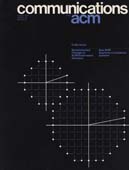August 1975 - Vol. 18 No. 8

Features
On the external storage fragmentation produced by first-fit and best-fit allocation strategies
Published comparisons of the external fragmentation produced by first-fit and best-fit memory allocation have not been consistent. Through simulation, a series of experiments were performed in order to obtain better data on the relative performance of first-fit and best-fit and a better understanding of the reasons underlying observed differences. The time-memory-product efficiencies of first-fit and best-fit were generally within 1 to 3 percent of each other. Except for small populations, the size of the request population had little effect on allocation efficiency. For exponential and hyperexponential distributions of requests, first-fit outperformed best-fit; but for normal and uniform distributions, and for exponential distributions distorted in various ways, best-fit out-performed first-fit. It is hypothesized that when first-fit outperforms best-fit, it does so because first-fit, by preferentially allocating toward one end of memory, encourages large blocks to grow at the other end. Sufficient contiguous space is thereby more likely to be available for relatively large requests. Results of simulation experiments supported this hypothesis and showed that the relative performance of first-fit and best-fit depends on the frequency of requests that are large compared to the average request. When the coefficient of variation of the request distribution is greater than or approximately equal to unity, first-fit outperformed best-fit.
Deterministic parsing of ambiguous grammars
Methods of describing the syntax of programming languages in ways that are more flexible and natural than conventional BNF descriptions are considered. These methods involve the use of ambiguous context-free grammars together with rules to resolve syntactic ambiguities. It is shown how efficient LR and LL parsers can be constructed directly from certain classes of these specifications.
Guarded commands, nondeterminacy and formal derivation of programs
So-called “guarded commands” are introduced as a building block for alternative and repetitive constructs that allow nondeterministic program components for which at least the activity evoked, but possibly even the final state, is not necessarily uniquely determined by the initial state. For the formal derivation of programs expressed in terms of these constructs, a calculus will be be shown.
Remark on stably updating mean and standard deviation of data
Although not published as a numbered algorithm, Hanson's article “Stably Updating Mean and Standard Deviation of Data” in the January, 1975, issue of Communications, [1] describes an algorithm for sequentially recomputing the mean and standard deviation of a weighted series of numbers when new numbers are added to the series. The procedure requires that only a summary matrix of data be retained, not the entire series, for the new mean and standard deviation to be computed.
Interactive consulting via natural language
Interactive programming systems often contain help commands to give the programmer on-line instruction regarding the use of the various systems commands. It is argued that it would be relatively easy to make these help commands significantly more helpful by having them accept requests in natural language. As a demonstration, Weizenbaum's ELIZA program has been provided with a script that turns it into a natural language system consultant.
Comments on a paper by T.C. Chen and I.T. Ho
Tien Chi Chen and Irving T. Ho in their paper “Storage-Efficient Representation of Decimal Data” [1] present a scheme for the compression of numbers stored in binary coded decimal (BCD) form. Their compression scheme involves coding two or three digits at a time in seven bit or ten bit fields and requires only permutations, deletions, and insertions for coding and decoding. We would like to briefly present some alternatives to their compression method and to discuss the relative advantages of these other methods.
Consecutive storage of relevant records with redundancy
This paper studies the properties of a new class of file organizations (CRWR) where records relevant to every query are stored in consecutive storage locations but the organizations contain redundancy. Some theorems which provide tools for reducing redundancy in CRWR organizations have been also developed. Redundancies obtained by the application of these theorems are compared with that of query-inverted file organizations. Some CRWR organizations with minimum redundancy have also been developed for queries which specify sets of keys.
Multiple byte processing with full-word instructions
A method is described which allows parallel processing of packed data items using only ordinary full-word computer instructions, even though the processing requires operations whose execution is contingent upon the value of a datum. It provides a useful technique for processing small data items such as alphanumeric characters.
Combining decision rules in a decision table
The techniques for minimizing logic circuits are applied to the simplification of decision tables by the combining of decision rules. This method is logically equivalent to the Quine-McCluskey method for finding prime implicants. If some of the decision rules implied in the ELSE Rule occur with low frequency, then the ELSE Rule can be used to further simplify the decision table.
Several objectives merit consideration in optimizing a decision table:
reducing machine execution time;
reducing preprocessing time;
reducing required machine memory;
reducing the number of decision rules. (This often improves the clarity of the decision table to a human reader.)
It will be shown that objectives (3) and (4) can be furthered with the above methods. Objective (1) is also attained if overspecified decision rules are not combined. Objective (2) must be compared against the potential benefits of objectives (1), (3), and (4) in deciding whether to use the above methods.



